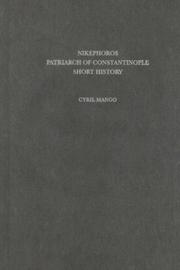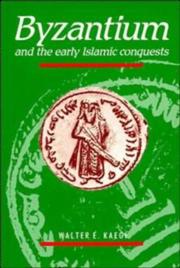| Listing 1 - 10 of 36 | << page >> |
Sort by
|
Book
ISBN: 0804714622 9780804714624 Year: 1988 Publisher: Stanford (Calif.): Stanford university press,
Abstract | Keywords | Export | Availability | Bookmark
 Loading...
Loading...Choose an application
- Reference Manager
- EndNote
- RefWorks (Direct export to RefWorks)
Byzantine Empire --- Empire byzantin --- History --- Histoire --- -History --- -Byzantine Empire --- 527-1081 --- Byzantine Empire - History - 527-1081
Book
ISBN: 8683883043 9788683883042 Year: 2003 Volume: 28 28 Publisher: Beograd: Srpska akademija nauka i umetnosti,
Abstract | Keywords | Export | Availability | Bookmark
 Loading...
Loading...Choose an application
- Reference Manager
- EndNote
- RefWorks (Direct export to RefWorks)
En serbe; trad. du titre: Les patriarches de Constantinople et les empereurs de la dynastie macédonienne
Constantinople (Ecumenical patriarchate) --- History --- Byzantine Empire --- Macédoine --- Byzantine Empire - History - 527-1081
Book
ISBN: 9780190253226 0190253223 9780190253240 019025324X Year: 2017 Publisher: New York, NY: Oxford university press,
Abstract | Keywords | Export | Availability | Bookmark
 Loading...
Loading...Choose an application
- Reference Manager
- EndNote
- RefWorks (Direct export to RefWorks)
In the second half of the tenth century, Byzantium embarked on a series of spectacular conquests: first in the southeast against the Arabs, then in Bulgaria, and finally in the Georgian and Armenian lands. By the early eleventh century, the empire was the most powerful state in the Mediterranean. It was also expanding economically, demographically, and, in time, intellectually as well. Yet this imperial project came to a crashing collapse fifty years later, when political disunity, fiscal mismanagement, and defeat at the hands of the Seljuks in the east and the Normans in the west brought an end to Byzantine hegemony. By 1081, not only was its dominance of southern Italy, the Balkans, Caucasus, and northern Mesopotamia over but Byzantium's very existence was threatened. How did this dramatic transformation happen? Based on a close examination of the relevant sources, this history — the first of its kind in over a century — offers a new reconstruction of the key events and crucial reigns as well as a different model for understanding imperial politics and wars, both civil and foreign. In addition to providing a badly needed narrative of this critical period of Byzantine history, Streams of Gold, Rivers of Blood offers new interpretations of key topics relevant to the medieval era. The narrative unfolds in three parts: the first covers the years 955-1025, a period of imperial conquest and consolidation of authority under the great emperor Basil "the Bulgar-Slayer." The second (1025-1059) examines the dispersal of centralized authority in Constantinople as well as the emergence of new foreign enemies (Pechenegs, Seljuks, and Normans). The last section chronicles the spectacular collapse of the empire during the second half of the eleventh century, concluding with a look at the First Crusade and its consequences for Byzantine relations with the powers of Western Europe. This briskly paced and thoroughly investigated narrative vividly brings to life one of the most exciting and transformative eras of medieval history.
Byzantine Empire --- History --- 527-1453. --- Byzantine Empire. --- 527-1453 --- Byzance --- Byzantine Empire - History - 527-1081 --- Byzantine Empire - History - 1081-1453
Book
ISBN: 9780521832311 0521832314 9781139055994 9781107685871 Year: 2008 Publisher: Cambridge, UK: Cambridge university press,
Abstract | Keywords | Export | Availability | Bookmark
 Loading...
Loading...Choose an application
- Reference Manager
- EndNote
- RefWorks (Direct export to RefWorks)
Byzantium lasted a thousand years, ruled to the end by self-styled 'emperors of the Romans'. It underwent kaleidoscopic territorial and structural changes, yet recovered repeatedly from disaster: even after the near-impregnable Constantinople fell in 1204, variant forms of the empire reconstituted themselves. The Cambridge History of the Byzantine Empire tells the story, tracing political and military events, religious controversies and economic change. It offers clear, authoritative chapters on the main events and periods, with more detailed chapters on particular outlying regions, neighbouring powers or aspects of Byzantium. With aids such as a glossary, an alternative place-name table and references to English translations of sources, it will be valuable as an introduction. However, it also offers stimulating new approaches and important new findings, making it essential reading for postgraduates and for specialists.
Byzantine Empire --- Empire byzantin --- History --- Histoire --- --Byzance --- --Byzantine Empire --- Byzance --- Byzantine Empire - History - 527-1081 --- Byzantine Empire - History - 1081-1453 --- 527-1081 --- 1081-1453

ISBN: 088402184X 9780884021841 Year: 1990 Volume: 13 10 Publisher: Washington: Dumbarton Oaks research library and collection,
Abstract | Keywords | Export | Availability | Bookmark
 Loading...
Loading...Choose an application
- Reference Manager
- EndNote
- RefWorks (Direct export to RefWorks)
Nicephorus, --- Translations into english --- Traductions anglaises --- Byzantine Empire --- Empire byzantin --- History --- Histoire --- -History --- -Byzantine Empire --- -Nicephorus, --- Byzantine Empire - History - 527-1081

ISBN: 0860781151 9780860781158 Year: 1983 Volume: 167 Publisher: Aldershot (Hants) : Variorum Repr.,
Abstract | Keywords | Export | Availability | Bookmark
 Loading...
Loading...Choose an application
- Reference Manager
- EndNote
- RefWorks (Direct export to RefWorks)
Byzantine Empire --- -History --- History, Military --- -Byzantine Empire --- -History, Military --- History --- Byzantine Empire - History - 527-1081 --- Byzantine Empire - History, Military - 527-1081

ISBN: 9780511470615 9780521411721 9780521484558 9781461949084 1461949084 0511470614 0521411726 0521484553 1139881884 1107384907 1107383692 1107390133 110739855X 0511953593 0511879741 Year: 1992 Publisher: Cambridge New York
Abstract | Keywords | Export | Availability | Bookmark
 Loading...
Loading...Choose an application
- Reference Manager
- EndNote
- RefWorks (Direct export to RefWorks)
This is a study of how and why the Byzantine Empire lost many of its most valuable provinces to Islamic (Arab) conquerors in the seventh century, provinces which included Syria, Palestine, Mesopotamia, and Armenia. It investigates conditions on the eve of those conquests, mistakes in Byzantine policy toward the Arabs, the course of the military campaigns, and the problem of local official and civilian collaboration with the Muslims. It also seeks to explain how, after terrible losses, the Byzantine government achieved some intellectual rationalisation of its disasters and began the complex process of transforming and adapting its fiscal and military institutions and political controls in order to prevent further disintegration.
Byzantine Empire --- Islamic Empire --- History --- Empire byzantin --- Empire islamique --- Histoire --- 527-1081 --- 622-661 --- Byzantine Empire - History - 527-1081. --- Islamic Empire - History - 622-661. --- Arts and Humanities

ISBN: 3222102937 9783222102936 Year: 1983 Volume: 15 Publisher: Graz: Styria,
Abstract | Keywords | Export | Availability | Bookmark
 Loading...
Loading...Choose an application
- Reference Manager
- EndNote
- RefWorks (Direct export to RefWorks)
Byzantine Empire --- History --- -History --- -Byzantine Empire --- -Byzantium (Empire) --- Vizantii︠a︡ --- Bajo Imperio --- Bizancjum --- Byzantinē Autokratoria --- Vyzantinon Kratos --- Vyzantinē Autokratoria --- Impero bizantino --- Bizantia --- Byzantijns Rijk. Geschiedenis. 9e-11e eeuw. (Bronnen) --- Skylitzès (Jean). Chronique. --- Byzance. Histoire. 9e-lle s. (Sources) --- Skylitzès (Jean). Chroniek. --- -Byzantijns Rijk. Geschiedenis. 9e-11e eeuw. (Bronnen) --- -Bajo Imperio --- Byzantium (Empire) --- Byzantine Empire - History - 527-1081 --- -Byzantine Empire - History - 527-1081
Book
ISBN: 0670802522 Year: 1991 Publisher: London New York Victoria Viking
Abstract | Keywords | Export | Availability | Bookmark
 Loading...
Loading...Choose an application
- Reference Manager
- EndNote
- RefWorks (Direct export to RefWorks)
Book
ISSN: 05771471 ISBN: 9782916716459 2916716459 Year: 2013 Volume: 17 Publisher: Paris: Association des amis du Centre d'histoire et civilisation de Byzance,
Abstract | Keywords | Export | Availability | Bookmark
 Loading...
Loading...Choose an application
- Reference Manager
- EndNote
- RefWorks (Direct export to RefWorks)
The title of this volume could be misleading. “Constructing the 7th century” by no means implies an intellectual construction. It should rather recall the image of a construction site with its scaffolding and piles of bricks, and with its plentiful uncovered pits. As on the building site of a medieval cathedral, every worker lays his pavement or polishes up his column knowing that one day a majestic edifice will rise and that it will be as accomplished and solid as is the least element of its structure. The reader can imagine the edifice as he reads through the articles collected under this cover, but in this age when syntheses abound it was not the editor’s aim to develop another one. The contributions to the volume, regrouped in five sections, explore various aspects of institutional, political and cultural life of the century producing unpublished material and new insights on some much debated topics.
Seventh century --- Septième siècle --- Byzantine Empire --- Empire byzantin --- History --- Histoire --- Byzantine antiquities --- Civilization --- Historiographie --- Byzantine empire --- 7th century --- Congresses --- Congresses. --- Septième siècle --- Historiographie. --- Byzantine antiquities - Congresses --- Byzantine Empire - History - 527-1081 - Congresses --- Byzantine Empire - Civilization - 527-1081 - Congresses
| Listing 1 - 10 of 36 | << page >> |
Sort by
|

 Search
Search Feedback
Feedback About UniCat
About UniCat  Help
Help News
News